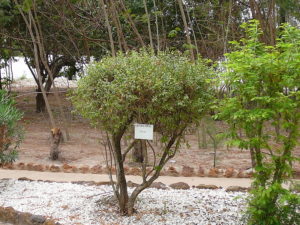
Henna is a mult-stem tree.
Henna (Lawsonia inermis) is a tall shrub or small multi stem tree native to Africa, Asia, and Northern Australia. The leaves are the source for the dye of the same name. The dye has been used for thousands of years to dye hair, nails, skin and fabric, including silk, wool and leather.
To obtain the dye, the leaves are dried and then ground into a powder. The powder is then mixed with a liquid such as lemon juice, water or tea. Once prepared, the dye must be used within one week or it will lose its dye properties. The leaf powder is stable and can be stored or shipped. Depending on the concentration of the leaf powder in the liquid, the resulting dye ranges in color from orange to reddish brown.
Henna also has medicinal uses. It has been used to treat headaches, joint aches, fevers and skin irritations. It has both antimicrobial and antibacterial properties and has been used to treat tuberculosis, coughs and burns.
Henna trees are used as hedging plants in tropical areas of the world.
The henna tree is only hardy in zones 10 – 12. Cooler temperatures below 70⁰F will cause it to drop its leaves. Temperatures below 50⁰F will kill it. The tree prefers full sun and well-drained soil. It can grow to 6 to 25 feet tall. If you live in a temperate climate and want to grow your tree in a container, it can be pruned to keep it small. Prune it in the spring before you put it outside. Prune both the top of your tree and the roots. The flowers are small and white. They have an intense fragrance. Bloom time is any time between spring and fall. The fruit is also small but contains between 32 and 49 seeds each.
It is possible to grow a henna tree from seed. You will need to soak the seeds for a week, changing the water daily. Then sow them in a container with pre-moistened soil barely covering them. They need some sunlight to germinate. Germination should occur in 2 weeks. If your seeds are slow to germinate, add a heat mat under your container to warm the soil.
Because this is a tree, it will grow slowly. You can start harvesting leaves when the tree is 5 years old.

